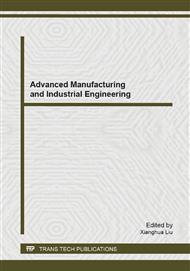[1]
Niezen, C. and Weller. Harvard Business Review, 2006, 84, (9), 22.
Google Scholar
[2]
Fisher, M.L. Harvard Business Review, 1997, 75 (2), 105-106.
Google Scholar
[3]
Randall, T., Ulrich, K. Product variety. Management Science, 2001(12), 588-604.
Google Scholar
[4]
Paul Childerhouse, James Aitken, Denis R. Towill. Journal of Operations Management, 2002, 20, (6), 675-689.
Google Scholar
[5]
Lamming, R., Johnsen, T., Zheng, J. and Harland, C. International Journal of Operations and Production Management, 2000, 20(6), 675-691.
DOI: 10.1108/01443570010321667
Google Scholar
[6]
Christopher, M., Towill, D.R. International Journal of Logistics Management, 2000, 13(1), 1-14.
Google Scholar
[7]
Christopher, M., Peck, H., Towill, D. The International Journal of Logistics Management, 2006, 17(2), 277-287.
Google Scholar
[8]
Lee, H.L. California Management Review, 2002, 44(3), 105-119.
Google Scholar
[9]
Van Hoek, R., Chapman, P. Supply Chain Management, 2006, 11(5), 385-389.
Google Scholar
[10]
Droge,C., Vickery S.K., Jacobs M.A. International Journal of Production Economics, 2012, 137, 250-262.
Google Scholar
[11]
Ellram, L.M., Stanley L.L. Journal of Purchasing and Supply Management, 2008, 14(3), 180-191.
Google Scholar
[12]
Forza,C., Salvador,F., Rungtusanatham,M. Journal of Operations Management, 2005, 23(3–4), 319-324.
Google Scholar
[13]
Park Y.W., Ogawa,K., Tatsumoto,H., Hong,P. International Journal of Services and Operations Management, 2009, 5(6), 787-798.
Google Scholar
[14]
Krishnan,V., Ulrich,K. Management Science, 2001, 47(1), 1-21.
Google Scholar
[15]
Fixson, S.K., Park, J-K. Research Policy, 2008, 37(8), 1296–1316.
Google Scholar
[16]
Fixson, S.K. Journal of Operations Management, 2005, 23(3), 345-369.
Google Scholar
[17]
Sharifi, H. Journal of Manufacturing Technology Management, 2006, 17(8), 1078-1098.
Google Scholar
[18]
Ulrich, K. Research Policy, 1995, 24(3), 419-440.
Google Scholar
[19]
Baldwin, C.Y. , Clark, K.B. Harvard Business Review, 1997, 75(9), 84-93.
Google Scholar
[20]
Fleming L, Sorenson O. Harvard Business Review, 2001, (9): 20-21.
Google Scholar
[21]
Ulrich, K. and Eppinger, S. . Boston: McGraw-Hill, (2005).
Google Scholar
[22]
Garcia, R. and Calantone, R. The Journal of Product Innovation Management, 2002, 19(4), 110-132.
Google Scholar
[23]
Steven C. Wheelwright, Kim B. Clark. Business Horizons, 1992, 35(4), 29-43.
Google Scholar
[24]
Martin, Ishii. Research in Engineering Design, 2002, 13(4), 213-235.
Google Scholar
[25]
Du,X., Xiao,J., Tseng M.M. Concuttent Engineering: Research and Application, 2001, 9(4), 103-119.
Google Scholar
[26]
Jiao. International Journal of Mass Customization, 2006, 1(2-3), 237-259.
Google Scholar
[27]
Pil, F. , Holweg, M. Interfaces, 2004, 34(5), 394-403.
Google Scholar
[28]
Hieber, R. Supply Chain Management: A Collaborative Performance Measurement Approach[M], Zurch: VDF, (2002).
Google Scholar
[29]
Fine, C. Clockspeed: Winning Industry Control in the Age of Temporary Advantage[M], New York: Perseus Books, (1995).
Google Scholar
[30]
Sturgeon, T. Industrial and Corporate Change, 2002, 11(3), 451-466.
Google Scholar
[31]
Abdelkafi, N. Variety-Induced Complexity in Mass Customization: Concepts and Management[M], Berlin: Erich Schmidt Verlag, (2008).
Google Scholar
[32]
Randall, T. , Ulrich, K. Management Science, 2001, 47(12), 588-604.
Google Scholar
[33]
Caridi, M., Pero, M., Sianesi, A. Proceedings of the Exxpand 2008, Bordeaux, France, 20-21 March.
Google Scholar
[34]
Selldin,E., Olhager,J. Supply Chain Management: An International Journal, 2007, 12(1), 42-51.
Google Scholar
[35]
Salvador, F., Forza, C. , Rungtusanatham, M. Journal of Operations Management, 2002, 20(5), 549-575.
Google Scholar
[36]
Zhaohui Wu: Supplier-supplier interactions and their effects on supply performance: an empirical study, A Dissertation Presented in Partial Fulfillment of the Requirements for the PHD.; Arizona State University, August (2003).
Google Scholar


